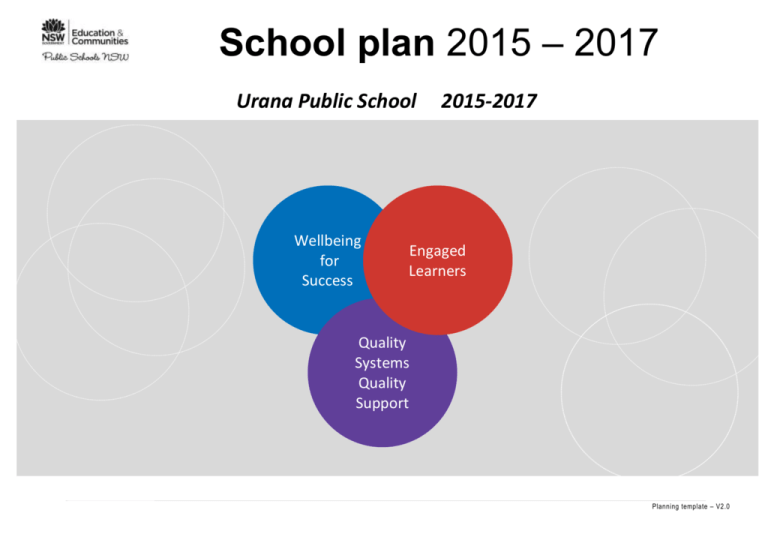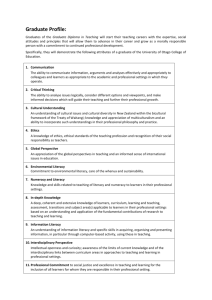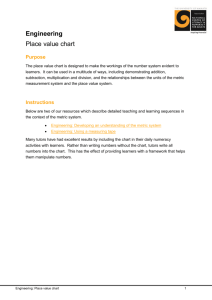School Plan 2015-2017
advertisement

School plan 2015 – 2017 Urana Public School Wellbeing for Success 2015-2017 Engaged Learners Quality Systems Quality Support Planning template – V2.0 School background 2015 - 2017 School vision statement School context School planning process Urana Public School is a quality learning environment that offers inclusive, personalized and innovative education. Urana Public School is located in the Riverina region, central to Wagga Wagga, Albury, Deniliquin and Griffith. The school caters for twenty eight students K6 in a rural setting. This is an aspirational plan developed with the school community – students, parents, staff and community members. They were consulted using the following methods: Typically it has a strong history of educational delivery for students from Urana and surrounds having been in existence for up to 150 years. The changing demographics of rural NSW is evidenced by school reclassification as a public school in 2015. Staff Development Days allowed all staff, the UPS team, including all administrative and teaching staff, to work together to look closely at what is happening in the school and to explore what needs to be in place to better meet the needs of all students. The community is characterized by an increasing percentage of families from low socio-economic backgrounds with aspirational dreams for their children’s’ future and who support the continuous improvement of the school in improving the literacy and numeracy outcomes for all students. A short survey was distributed to parents, staff and students in a ‘3 wishes and a star’ format. Quality literacy and numeracy programs such as Focus on Reading (FoR), Language Literacy and Learning (L3), Targeting Early Numeracy (TEN) and Taking Off With Numeracy (TOWN) drive the quest for literacy and numeracy growth for all students. The parent body worked with the principal to define a vision – ‘What is the school here for?’ This assisted in informing the development of the three strategic directions. Every student has the opportunity to achieve their personal best through engaged learning in a safe, respectful, supportive and caring environment. Urana Public School prepares resilient, socially confident, independent learners. All parents were invited, through casual conversations at the 2014 UPS Presentation Night, to engage with the principal about improvements the school could make. The BiJOU Learning Community encompasses Urana, Berrigan, Jerilderie and others and provides a vehicle to develop teachers’ capacity to meet the literacy and numeracy needs of all students. Professional learning with others is a valuable tool in self-improvement. [School name and school code] Page 2 Planning template – V2.0 School strategic directions 2015 - 2017 STRATEGIC DIRECTION 1 STRATEGIC DIRECTION 2 STRATEGIC DIRECTION 3 Wellbeing for Success Engaged Learners Quality Systems Quality Support Purpose: Purpose: Purpose: To ensure every student is equipped with the social, emotional and physical skills that will empower them to engage in and enjoy meaningful relationships and experiences in preparation for a successful life-long learning journey. To embrace academic excellence and develop learners who will become successful and informed citizens in a changing world. To build meaningful partnerships with our learning communities, to build the capacity of individuals to be innovative in a highly supported environment. To guide learners to become resilient, independent and adaptable, who in turn are accountable for their learning and achievement. [School name and school code] Page 3 Planning template – V2.0 Strategic Direction 1: Wellbeing for Success Purpose People Processes Products and Practices Why do we need this particular strategic direction and why is it important? How do we develop the capabilities of our people to bring about transformation? How do we do it and how will we know? What is achieved and how do we measure? To ensure every student is equipped with the social, emotional and physical skills that will empower them to engage in and enjoy meaningful relationships and experiences in preparation for a successful life-long learning journey. Students: Build students’ capacity to learn by explicitly teaching the dispositions and habits within existing programs and practices to develop a clever learner's toolkit that gives students the skills to become: Successful learners, who enjoy learning, make connections and transfer knowledge and skills Confident individuals who are able to live a safe, healthy and fulfilling lives Active and responsible citizens who make a positive contribution to the wellbeing of present and future generations. Personalised Learning and Behaviour Plans written for all students Improvement Measures Personalised Learning and Behaviour Plans written for all students All students show a demonstrated and measurable improvement in behaviour, attendance and social and leadership choices Develop the five dispositions: resilience, reciprocity, reflectiveness, resourcefulness and responsibility, allowing them to contribute to the building of a positive learning culture and of which they are integral and feel valued. Staff: Engage in and demonstrate a commitment to lifelong learning. This commitment reflects their growing ability to explore the possibilities and provide differentiated learning activities to develop the holistic student and provide a learning environment that promotes the development of the five dispositions. Parents/Carers: Develop an understanding of the skills required for successful learning and can support their children by being actively supportive of the learning and achievement of these within the school. Learning Community: Continue the sharing of opportunities and experiences for students. Collegial support with professional development to address the well-being of the To develop and encourage expanded professional knowledge for staff and parents of programs offered by interagencies , supplemented by programs that can complement existing school programs ie. Growing Great Kids, Fast ForWord, Calmer Classrooms, Bounce Back and their relevance/their benefits in the school context Evaluation Plan How2Learn trainer’s professional learning completed All students show a demonstrated and measurable improvement in behaviour, attendance and social and leadership choices Product: Students are active participants in school programs and ambassadors of the school within the community. Practice: Students are self-aware, have the skills to build positive relationships and actively contribute to the school, community and society in which they live. Product: The school actively seeks to involve support services and interagency groups as the building blocks to identify and support individual needs. Practice: High levels of collaboration and information sharing exist between the school, families and key agencies to personalise support for all students. [School name and school code] Page 4 Planning template – V2.0 students and the impact it has on student learning. Staff trained in higher order ways of learning Personalised Learning and Behaviour Plans developed for all students Student tracking sheet updated regularly [School name and school code] Page 5 Planning template – V2.0 Strategic Direction 2: Engaged Learners Purpose People Processes Products and Practices Why do we need this particular strategic direction and why is it important? How do we develop the capabilities of our people to bring about transformation? How do we do it and how will we know? What is achieved and how do we measure? Students have the opportunities to explore how they learn best and develop a range of skills, knowledge and understanding of the range of tools available to support them. External and school based data shows learning growth for all students To embrace academic excellence and develop learners who will become successful and informed citizens in a changing world. To guide learners to become resilient, independent and adaptable, who in turn are accountable for their learning and achievement. Improvement Measures Students are collaborative, creative and productive users of technology and confident communicators using technology External and school based data shows learning growth for all students Students: That students will become true 21C learners, harnessing their naturally inquisitive and curious minds to develop collaborative, communicative, creative, critical skills in order to become active and informed citizens of the future. Staff: Engage all staff in professional development that is, relevant, future focused and shaped by research, evidence and feedback to build their capacity as learners, teachers and leaders. Differentiated professional learning exists for school administration staff. Parents/Carers: Parents become active participants and learners in the school environment. They will gain a better understanding of the learning progress of their children and how to effectively support them to learn. Parents will be provided the opportunity, support and encouragement to be part of learning process to develop their knowledge and Teaching staff develop deeper knowledge and skills together with increasing confidence in using the tools for learning including technology, to increase the opportunities to personalise student learning. Students are collaborative, creative and productive users of technology and confident communicators using technology Product: Teachers regularly input data into PLAN, update student tracking sheets and provide feedback to students Build a culture of learning - use the language of learning across the school, actively demonstrate the dispositions of successful learners and believe that intelligence is learnable and expandable. Practice: Evaluation Plan Product: Monitoring attendance levels closely Analysis of all external/internal assessment data to track student achievement School self-evaluation processes used to evaluate teaching and learning Teachers utilise the data to plan explicit learning experiences to move students along the literacy and numeracy continuums, learning is differentiated for all students Increased evidence of use of technology as a tool for learning, increased opportunity for staff and students to explore how technology can work for them Practice: Students regularly select appropriate tool that best allows them to demonstrate their learning [School name and school code] Page 6 Planning template – V2.0 skills about the tools of learning. Learning Community: Continue to grow professional learning opportunities which will support, share and offer opportunities for collaboration for leaders, teachers and students. programs, projects learning experiences and student/staff/parent involvement in extra curricula events Termly parent learning afternoons All students complete learning styles survey [School name and school code] Page 7 Planning template – V2.0 Strategic Direction 3: Quality Systems, Quality Support Purpose People Processes Products and Practices Why do we need this particular strategic direction and why is it important? How do we develop the capabilities of our people to bring about transformation? How do we do it and how will we know? What is achieved and how do we measure? To build meaningful partnerships with our learning communities, to build the capacity of individuals to be innovative in a highly supported environment. Students: Are provided with opportunities to provide relevant feedback to their teachers and to school leaders to inform school planning Staff: Improvement Measures The iPads in Classrooms initiative results in enthusiasm for what technology adds to the learning, confidence in its application and the sharing of the excitement of student achievement . Engage in the professional learning process. They are active participants and regularly engage in individual, team and formal reflection processes. Collaboration is a feature of the planning and evaluative cycle within the school and is valued by staff as an opportunity to share expertise and grow professionally. Investigating and embedding innovative systems, programs or settings to support teacher and student learning that targets the development of their personal goals. Expand the role of the learning community to enable students, teachers, leaders and parents to share resources, learning opportunities, professional dialogue and develop professional networks. Attainment by all teachers of their identified performance and development goals and ensuring they meet the Australian Professional Standards for Teachers Evaluation Plan Term learning community meetings – discuss direction and evaluate journey so far, where to from here? Tell Them From Me - Student, Staff and Parent surveys [when available] 3 stars and 1 wish survey conducted annually by students, parents and staff Learning Community: Utilise shared knowledge and skills and provide opportunities for staff to connect, collaborate and participate in quality professional learning. Attainment by all teachers of their identified performance and development goals and ensuring they meet the Australian Professional Standards for Teachers Product: Parents/Carers: Accept opportunities to be an active participant in developing their understanding of the learning which is occurring in the school. The iPads in Classrooms initiative results in enthusiasm for what technology adds to the learning, confidence in its application and the sharing of the excitement of student achievement . Reflection and evaluation of teaching practices through the Performance and Development Framework. Collaboratively develop mechanisms to support quality collegial feedback. The teaching staff of the school demonstrate and share expertise and welcome innovative effective learning opportunities for both students and staff. Practice: Teaching staff demonstrate and share expertise, have very high levels of contemporary content knowledge and teaching practices and utilise evidence based teaching strategies. Teachers collaborate within the school, across learning communities and across multiple networks to ensure consistency of curriculum delivery, strategies for differentiation and consistency of teacher judgement. Product: [School name and school code] Page 8 Planning template – V2.0 All teachers will have high level knowledge of professional standards and will demonstrate strong evidence regarding achievement of all performance and development goals Practice: School Leader places a high priority on the ongoing professional learning of all staff and participates in professional learning alongside teachers. Staff participation in team teaching, peercoaching activities, mentoring and feedback sessions will support professional growth. [School name and school code] Page 9 Planning template – V2.0






